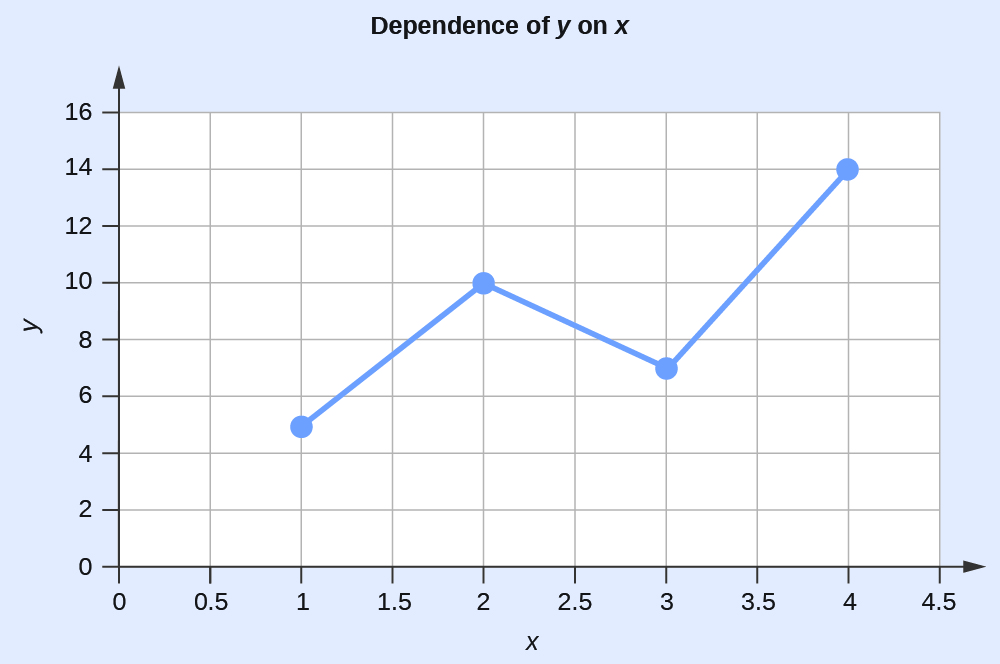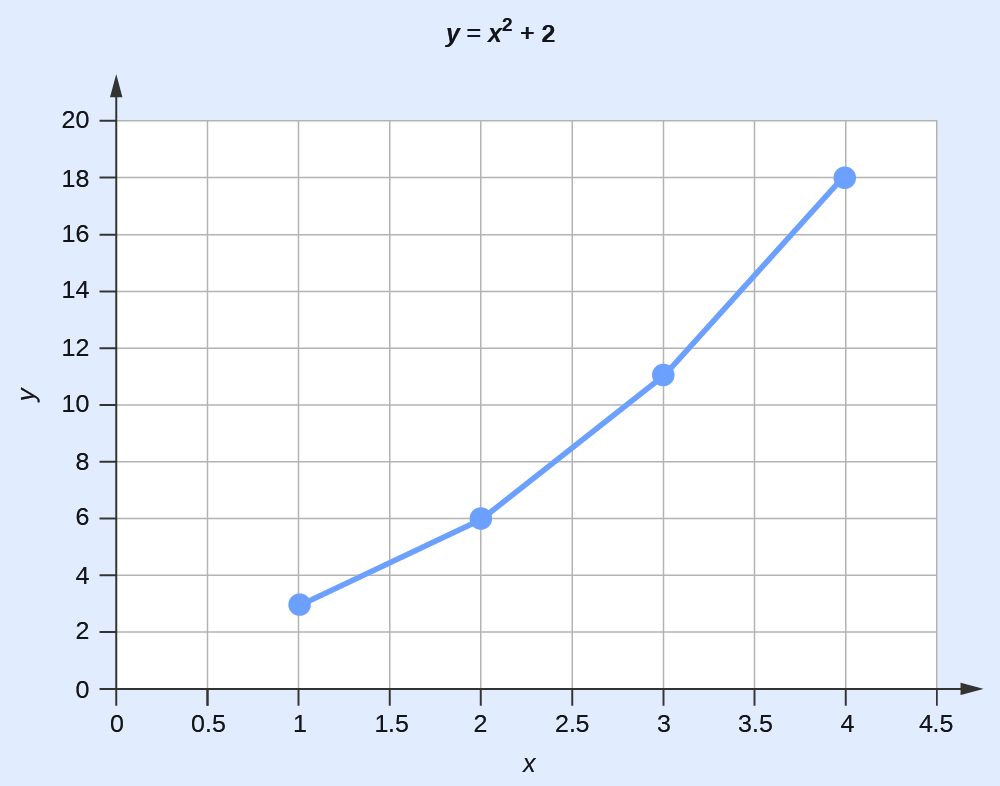Appendix B: Essential Mathematics
Exponential Arithmetic
Exponential notation is used to express very large and very small numbers as a product of two numbers. The first number of the product, the digit term, is usually a number not less than 1 and not greater than 10. The second number of the product, the exponential term, is written as 10 with an exponent. Some examples of exponential notation are:
| 1000 | = 1 × 103 |
| 100 | = 1 × 102 |
| 10 | = 1 × 101 |
| 1 | = 1 × 100 |
| 0.1 | = 1 × 10-1 |
| 0.001 | = 1 × 10-3 |
| 2386 | = 2.386 × 1000 = 2.386 × 103 |
| 0.123 | = 1.23 × 0.1 = 1.23 × 10-1 |
The power (exponent) of 10 is equal to the number of places the decimal is shifted to give the digit number. The exponential method is particularly useful notation for every large and very small numbers. For example, 1,230,000,000 = 1.23 × 109, and 0.00000000036 = 3.6 × 10−10.
Addition of Exponentials
Convert all numbers to the same power of 10, add the digit terms of the numbers, and if appropriate, convert the digit term back to a number between 1 and 10 by adjusting the exponential term.
Example 1
Adding Exponentials
Add 5.00 × 10−5 and 3.00 × 10−3.
Solution
3.00 × 10-3 = 300. × 10-5
(5.00 × 10-5) + (300. × 10-5) = 305 × 10-5 = 3.05 × 10-3
Subtraction of Exponentials
Convert all numbers to the same power of 10, take the difference of the digit terms, and if appropriate, convert the digit term back to a number between 1 and 10 by adjusting the exponential term.
Example 2
Subtracting Exponentials
Subtract 4.0 × 10−7 from 5.0 × 10−6.
Solution
4.0 × 10−7 = 0.40 × 10−6
(5.0 × 10-6) – (0.40 × 10−6) = 4.6 × 10-6
Multiplication of Exponentials
Multiply the digit terms in the usual way and add the exponents of the exponential terms.
Example 3
Multiplying Exponentials
Multiply 4.2 × 10−8 by 2.0 × 103.
Solution
(4.2 × 10-8) × (2.0 × 103) = (4.2 × 2.0) × 10(-8) + (+3) = 8.4 × 10-5
Division of Exponentials
Divide the digit term of the numerator by the digit term of the denominator and subtract the exponents of the exponential terms.
Example 4
Dividing Exponentials
Divide 3.6 × 105 by 6.0 × 10−4.
Solution
![]()
Squaring of Exponentials
Square the digit term in the usual way and multiply the exponent of the exponential term by 2.
Example 5
Squaring Exponentials
Square the number 4.0 × 10−6.
Solution
(4.0 × 10−6)2 = (4.0 × 4.0) × 10(−6)×2 = 16 × 10−12 = 1.6 × 10−11
Cubing of Exponentials
Cube the digit term in the usual way and multiply the exponent of the exponential term by 3.
Example 6
Cubing Exponentials
Cube the number 2 × 104.
Solution
(2 × 104)3 = (2 × 2 × 2) × 10(4)×3 = 8 × 1012
Taking Square Roots of Exponentials
If necessary, decrease or increase the exponential term so that the power of 10 is evenly divisible by 2. Extract the square root of the digit term and divide the exponential term by 2.
Example 7
Finding the Square Root of Exponentials
Find the square root of 1.6 × 10−7.
Solution
1.6 × 10−7 = 16 × 10−8
![]()
The Use of Logarithms and Exponential Numbers
The common logarithm of a number (log) is the power to which 10 must be raised to equal that number. For example, the common logarithm of 100 is 2, because 10 must be raised to the second power to equal 100. Additional examples follow.
| Number | Expressed Exponentially | Common Logarithm |
| 1000 | 103 | 3 |
| 10 | 101 | 1 |
| 1 | 100 | 0 |
| 0.1 | 10−1 | −1 |
| 0.001 | 10−3 | −3 |
What is the common logarithm of 60? Because 60 lies between 10 and 100, which have logarithms of 1 and 2, respectively, the logarithm of 60 is 1.7782; that is
60 = 101.7782
The common logarithm of a number less than 1 has a negative value. The logarithm of 0.03918 is −1.4069, or
0.03918 = 10-1.4069 = ![]()
To obtain the common logarithm of a number, use the log button on your calculator. To calculate a number from its logarithm, take the inverse log of the logarithm, or calculate 10x (where x is the logarithm of the number).
The natural logarithm of a number (ln) is the power to which e must be raised to equal the number; e is the constant 2.7182818. For example, the natural logarithm of 10 is 2.303; that is
10 = e2.303 = 2.71828182.303
To obtain the natural logarithm of a number, use the ln button on your calculator. To calculate a number from its natural logarithm, enter the natural logarithm and take the inverse ln of the natural logarithm, or calculate ex (where x is the natural logarithm of the number).
Logarithms are exponents; thus, operations involving logarithms follow the same rules as operations involving exponents.
- The logarithm of a product of two numbers is the sum of the logarithms of the two numbers.
log xy = log x + log y and ln xy = ln x + ln y
- The logarithm of the number resulting from the division of two numbers is the difference between the logarithms of the two numbers.
 and
and 
- The logarithm of a number raised to an exponent is the product of the exponent and the logarithm of the number.
log xn = n(log x) and ln xn = n(ln x)
The Solution of Quadratic Equations
Mathematical functions of this form are known as second-order polynomials or, more commonly, quadratic functions.
ax2 + bx + c = 0
The solution or roots for any quadratic equation can be calculated using the following formula:
![]()
Example 8
Solving Quadratic Equations
Solve the quadratic equation 3x2 + 13x − 10 = 0.
Solution
Substituting the values a = 3, b = 13, c = −10 in the formula, we obtain
![]()
![]()
The two roots are therefore
![]() and
and ![]()
Quadratic equations constructed on physical data always have real roots, and of these real roots, often only those having positive values are of any significance.
Two-Dimensional (x–y) Graphing
The relationship between any two properties of a system can be represented graphically by a two-dimensional data plot. Such a graph has two axes: a horizontal one corresponding to the independent variable, or the variable whose value is being controlled (x), and a vertical axis corresponding to the dependent variable, or the variable whose value is being observed or measured (y).
When the value of y is changing as a function of x (that is, different values of x correspond to different values of y), a graph of this change can be plotted or sketched. The graph can be produced by using specific values for (x,y) data pairs.
Example 9
Graphing the Dependence of y on x
| x | y |
| 1 | 5 |
| 2 | 10 |
| 3 | 7 |
| 4 | 14 |
This table contains the following points: (1,5), (2,10), (3,7), and (4,14). Each of these points can be plotted on a graph and connected to produce a graphical representation of the dependence of y on x.
If the function that describes the dependence of y on x is known, it may be used to compute x,y data pairs that may subsequently be plotted.
Example 10
Plotting Data Pairs
If we know that y = x2 + 2, we can produce a table of a few (x,y) values and then plot the line based on the data shown here.
| x | y = x2 + 2 |
| 1 | 3 |
| 2 | 6 |
| 3 | 11 |
| 4 | 18 |

Please use this form to report any inconsistencies, errors, or other things you would like to change about this page. We appreciate your comments. 🙂

